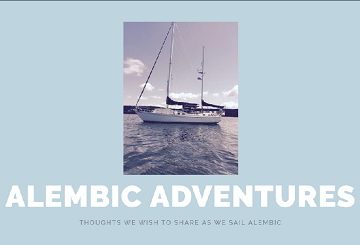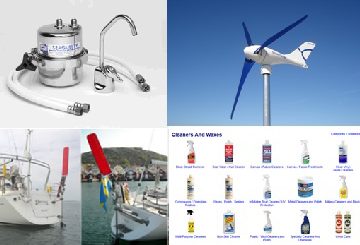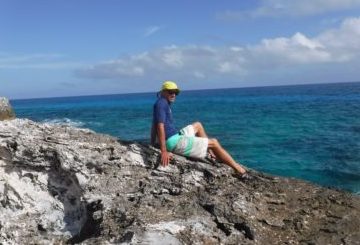Atlantic Crossing
Day four of an offshore passage seems to be the day when time and distance finally drift to the background. The journey becomes the focus not the landfall. During the first few days of a passage, I am constantly thinking about boat speed, distance covered, and the number of days still required to achieve the destination. This obsession takes me away from the enjoyment of the activities and observations of the passage itself. By the fourth day of a passage, the body has acclimated to the motion of the sea. Sleep patterns have been established, adjusting to the disruption of the three hour night watch that breaks into the peace of uninterrupted sleep that we enjoy while in port. I am finally settling into the journey and becoming reflective of the present. I am living in the moment. Listening to the whispers of the boat in harmony with the environment. Watching the sea and the sails.

A beautiful day for a sail in the middle of the Atlantic in June
Like many similar undertakings, preparing and getting underway for an offshore passage seems like an endless task in itself. We make lists of tasks that need to be completed. I often realize half way through the day that I am doing things that are necessary but not even on the list! The list seems never complete. Other lists highlight supplies that we need to find locally or order from afar. We often describe the efforts to find unique items locally in foreign ports as “easter egg hunts”. This is especially true for marine parts or specialty hardware items. As the departure date approaches, the window to order parts from afar quickly closes and the “easter egg hunts” become even more urgent.
As departure date approaches, the sense of inertia begins to build. “Will we ever get this boat moving again” becomes the sentiment. Anxiety seems to creep into decision making and conversations become more terse and strained. Are we prepared; will we see bad weather; will we have gear failures. These thoughts contribute to the building anxiety.
Finally, it is time to go. There will be a few things on the list undone. A standing joke among sailors is that there are always people who feel they need to finish just “one more spice rack” before the boat is ready. These people never seem to leave port and if they do, they don’t get very far before “the list” drives them back into port. There will always be tasks on the list to complete. Only safety related and critical repairs should keep the vessel in port.
Raising the anchor breaks the inertia and the passage begins. Anxieties remain for the first few hours until the boat is finally at sea and sails are set and trimmed for the sea conditions. The self-steering is engaged so the boat is sailing herself. It is time to settle into the passage, get in tune with the sea – ride the boat. When conditions are perfect, it is easy to feel like a passenger. The boat and the wind are in command.
Pre-departure anxieties have faded but new concerns become the focus of planning and thinking. Wind strength and direction, sea state, squalls, and currents dominate our thoughts. We have multiple ways to learn about weather. Before departure when we still have wifi, we download forecast data from the internet into our favorite applications. My latest favorite is Predict Wind Offshore. I download new grib files every 12 hours or so and study the wind and gust images for time windows out to 14 days. It is surprising how much the images change every few days. The forecasts are based on complex models developed and maintained by US and European governments. The model accuracy fades quickly too far into the future. This dense, pre-departure data helps determine a departure day but is only available at sea for those with expensive satellite data systems. Our other primary source for both pre-departure and post-departure information is the SSB radio broadcasts with our weather service provider, Chris Parker. Chris provides forecast overviews as well as custom forecasts for a boats position, course, speed, and destination. While at sea we attempt to talk with Chris each evening to obtain a forecast for the immediate and near-term future.
Radio schedules are events that add routine to life offshore. We typically participate in three types of radio nets. There is the Chris Parker weather net in both the morning and evenings. Sometimes we just listen to other boats conversations with Chris. Other times since we are a “subscribing vessel” we speak with Chris Parker directly. We give him our position and he provides a custom forecast for our experience over the next few days. We have found that other cruisers sometimes track our progress via these discussions. Several years ago we made an unscheduled stop in Ile-a-Vache Haiti. A cruiser anchored there welcomed us and said that he had been expecting us based on our radio discussions with Chris!
The other radio nets that we enjoy are position reporting and social nets. These tend to blend together. Both the Ocean Cruising Club and the Seven Seas Cruising Association organize position reporting nets for vessels in the Caribbean and Atlantic waters. During our recent passage between USVI-Bermuda-Azores, we participated in a seasonal net hosted by the SSCA entitled The Transatlantic Safety and Security Net. We checked-in each day at 2130 UTC and reported our position. We enjoyed hearing about the positions of other vessels also crossing the Atlantic with us. We were a group of 9 boats spanning 500 miles of ocean all heading to the Azores. Once we arrived in Horta we were already old friends.
Meals and snacking also adds routine to the passage. The evening meal seems to be the best time for the crew to gather in the cockpit for some together time. The weather often dictates the complexity of the meal. During rough weather meals are more simple and easier to prepare for the cook. During settled weather, cravings tend to inspire us to prepare more elaborate meals. Snacking also becomes an event. For me, I enjoy preparing a special snack for my night watch. It becomes a ritual that I look forward to and helps wake me up and settle into my duties through the night. Everyone aboard seems to have their own version of “comfort food”. It is important to make sure this is part of provisioning.
In this time of low cost satellite-based communication devices, it is possible to keep in touch with loved-ones and friends while offshore. We use a Garmin inReach device as our primary link to folks ashore as well as those afloat. The unlimited texting feature allows us to have casual communication with friends and family while also providing the security of emergency SOS contact. We often banter with friends and family throughout our passages. Folks ashore find the messages that also contain latitude and longitude position as a way to join us vicariously on our passage. We find that many other cruising vessels also have inReach type devices so we also communicate to these friends without wondering if they are in port or at sea because no cell service is required for them to receive our messages.
As the days pass on an offshore passage. The calendar is forgotten, and life is in sync with the rhythms of day and night and of course the weather. Days seem to pass quickly as the routines of the day seem to click off – cooking, eating, napping, reading, sail handling, maintenance, and more napping. The night time watch becomes something to look forward to instead of a burden. Since we do a one-man watch, this is the time for solitude and star gazing.
The sea offers opportunities to experience wildlife like no other setting. On our recent passage from Bermuda to the Azores, we spotted whales on two occasions. We watched for whales spouting, whales basking, and were rewarded with several breaching whales. Birds were also constant companions. Shearwaters are common in mid-ocean. They can be seen during calms as well as gales as if weather is not relevant to their comfort. And then of course there are the dolphins. At sea we frequently are befriended by pods of dolphin who visit us throughout the day. They dash in directly to the boat, swim under our bow for a few minutes and then dash off as quickly as they arrived.

Sperm whales greet us as we approach Horta
Weather becomes an event to add variety to the days at sea. Brisk wind drives the boat faster and the speed and motion makes cooking, sleeping, and moving about more challenging. It is also exhilarating to spend time in the cockpit enjoying the spectacle of the waves and the way the boat moves in harmony in this new terrain. Settled weather always follows the rough weather. These more settled days are welcome and offer a chance to catch up on sleep, dry out wet clothing and prepare meals in a quiet galley. Trade wind sailing is wonderful for its consistency, but there is also something nice about the variety of rough weather and calms that are found in the higher latitudes. Weather is not to be feared but understood. Without the weather, there would be no journey to experience.

Sunset over a calm sea in the middle of the Atlantic

Raising the Q flag

Boats line the wall in Horta, Azores
Arrival at the end of a successful passage is a triumphant event! It marks the achievement of a unique experience that is becoming increasingly rare in our world of technology, connectivity, and refined comforts. Sailing small boats long distances has never been safer with the equipment, navigation, and communication available to sailors today. The offshore passage, however, is still a unique adventure where a person is able to step into an environment unchanged for thousands of years and experience the sea in much the same way as the sailors from the past. The journey is the experience, not just the destination.
































































































































































